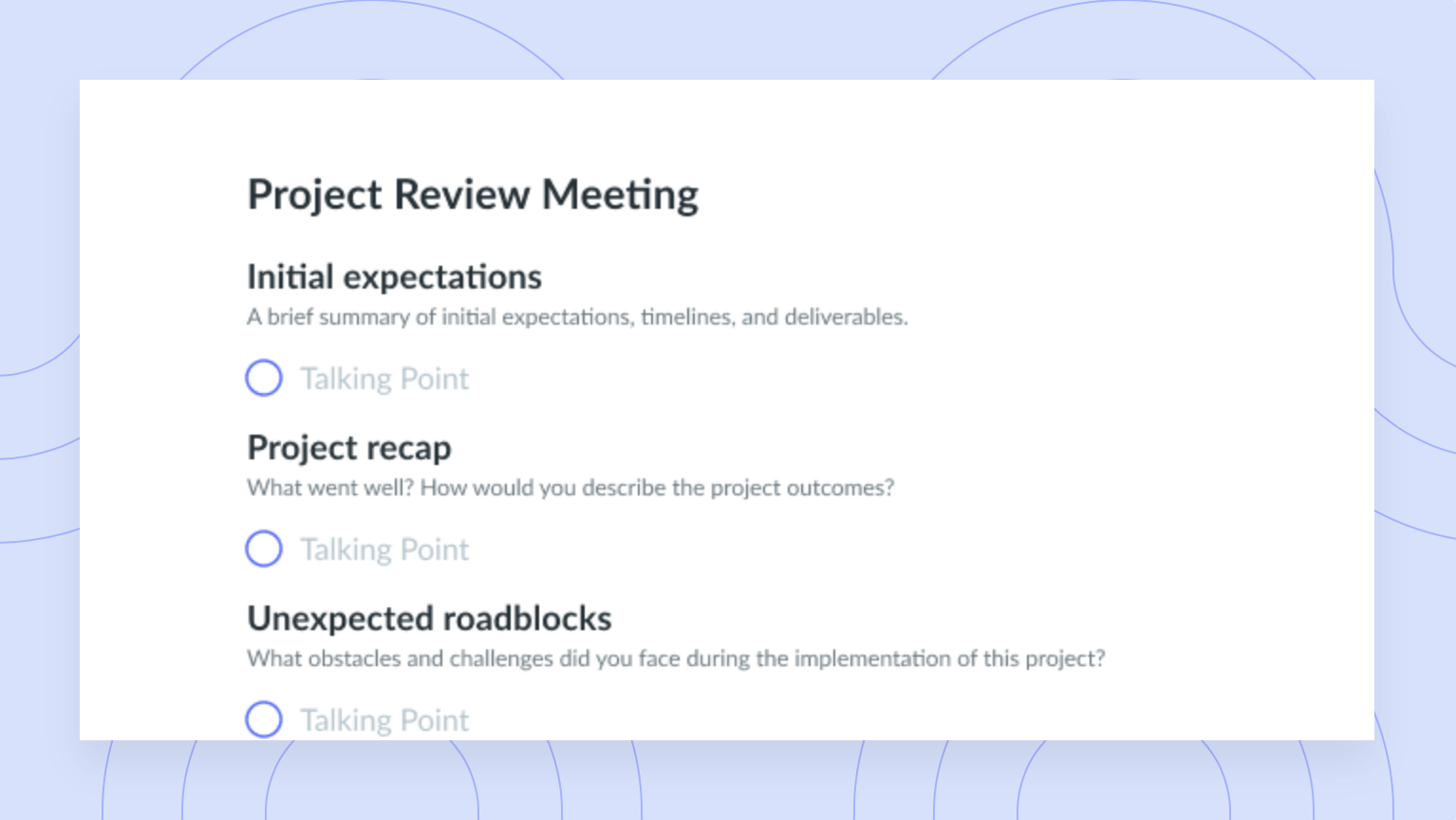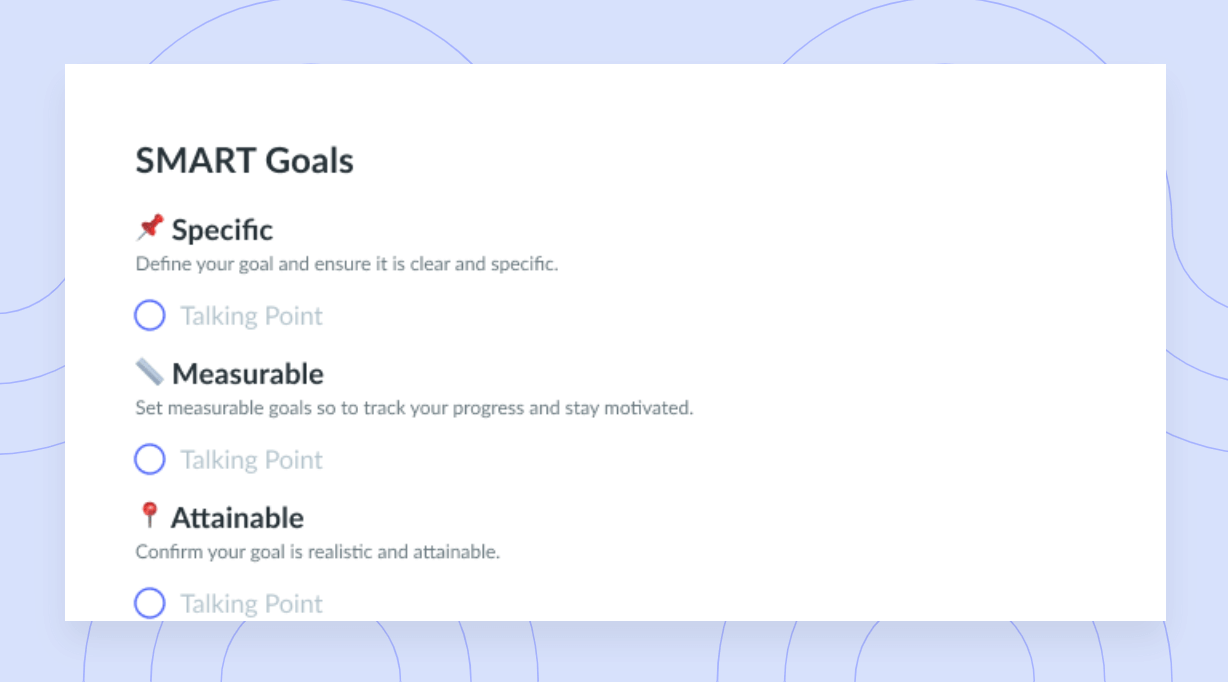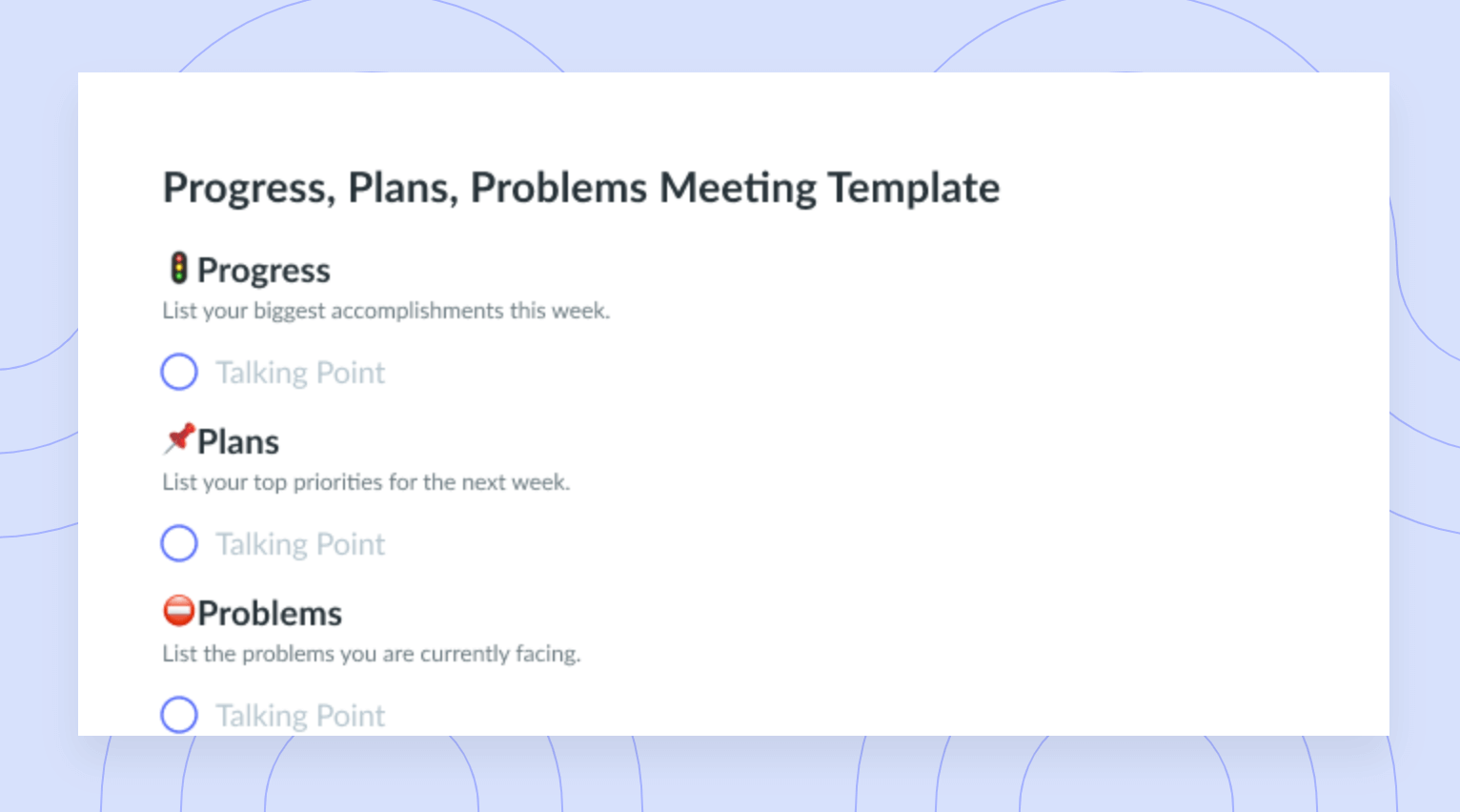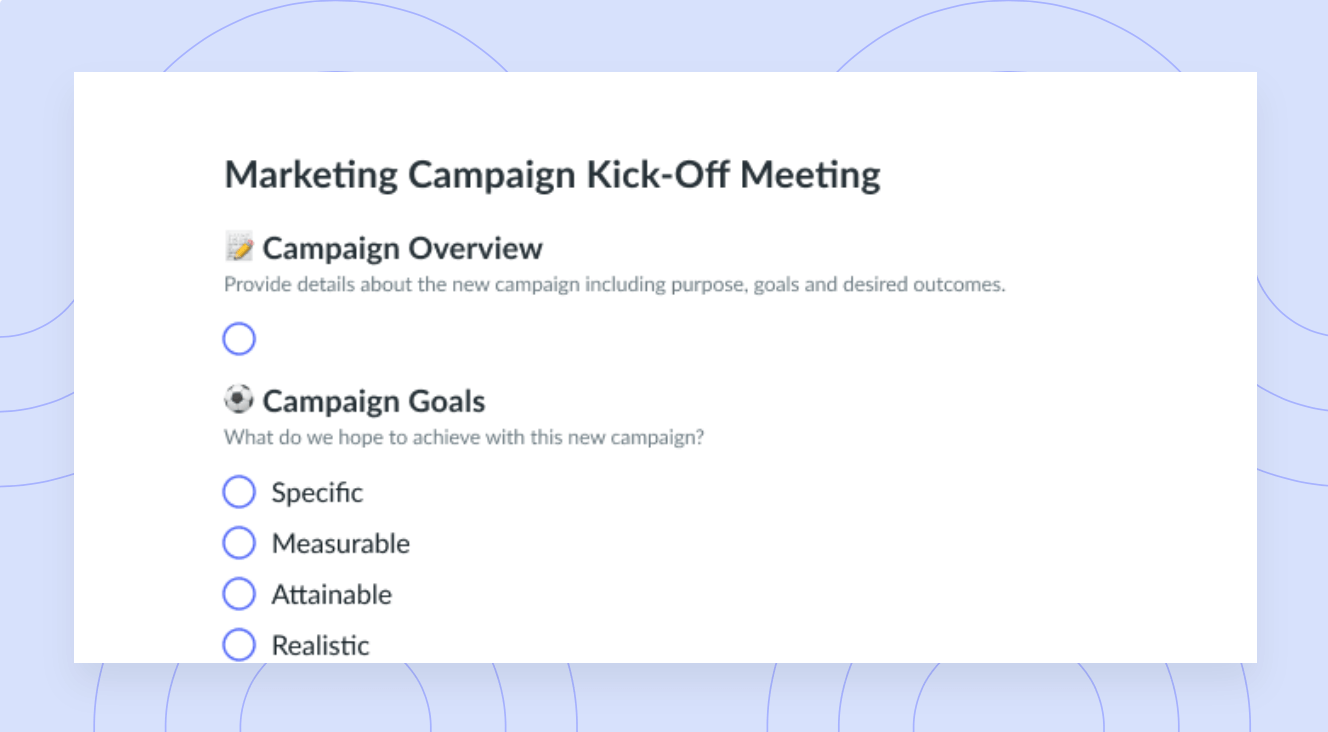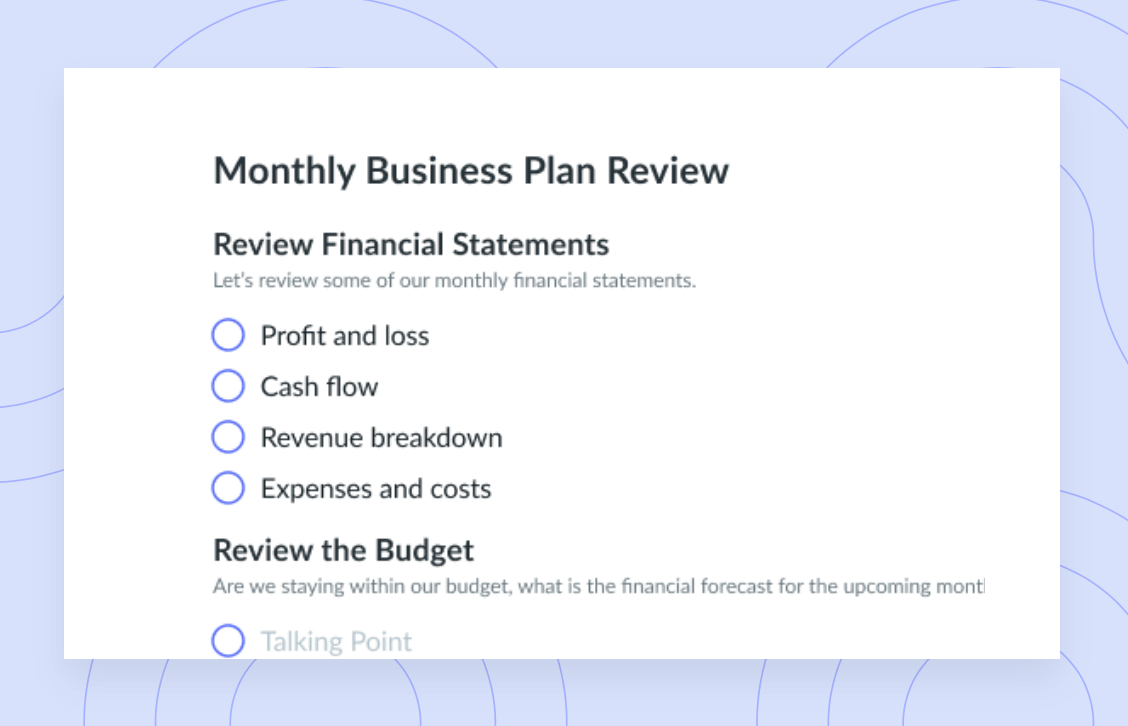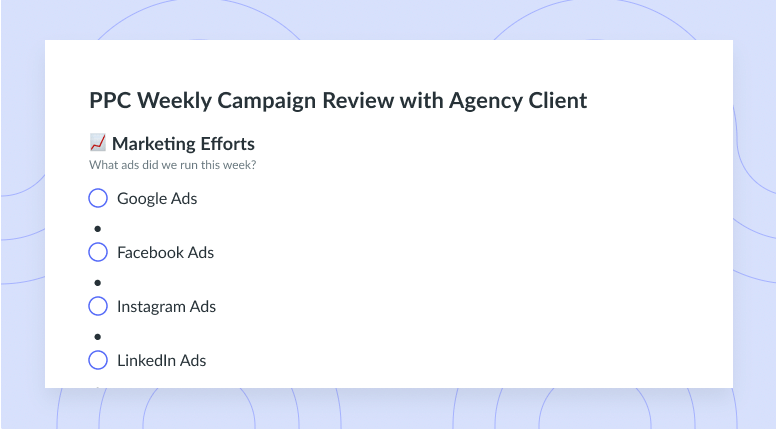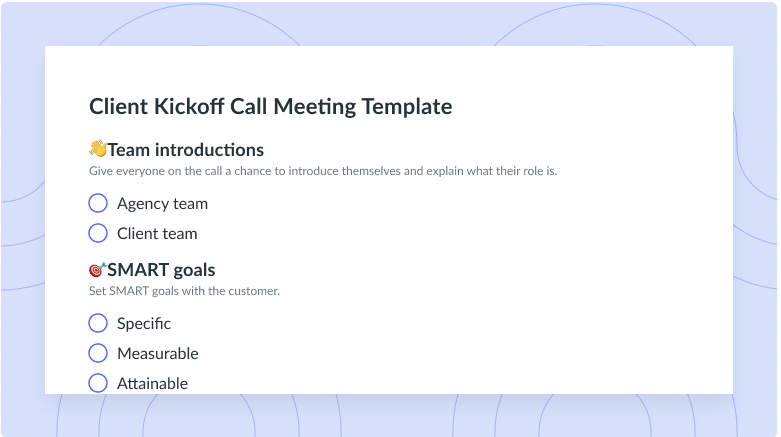Meeting Objectives Mastery: How to Set a Meeting Purpose
Learn how to avoid unproductive meetings and get time back with these meeting objective examples and tips.
An unproductive meeting can feel like taking one step forward and two steps back. Yes, you successfully found a time for everyone to chat and got everyone in the room; however, the group didn’t quite do what you all needed to, and now you need to spend time trying again. Avoiding these unproductive meetings—and getting tons of time back—is way more likely when you set clear meeting objectives. Here’s how to do exactly that, with some meeting objective examples for reference.
- What are meeting objectives?
- Why should every meeting have a clear objective?
- Difference between meeting purpose and the meeting objective
- Sample meeting objectives
- How to write a meeting objective
What are meeting objectives?
A meeting objective is a measurable goal toward which your team works during a meeting. It’s basically your meeting’s ideal outcome. It’s also the answer to the question, “What are we doing at this meeting?” Meeting objectives outline what the meeting aims to achieve and provide a clear direction for the discussion. Well-defined objectives are crucial for effective meetings, as they help ensure that the time spent is productive, focused, and relevant to the participants’ needs. Meeting objectives should be clear and understandable to all participants. They should outline specific topics to be discussed or decisions to be made, rather than general or broad statements.
For example, in a project planning meeting, an objective might be “To finalize and approve the project timeline and key milestones,” which is clear, specific, and measurable. In a brainstorming session, an objective could be “To generate at least 10 new ideas for the upcoming marketing campaign,” which is specific, achievable, and purpose-driven.

Meetings worth showing up to
A well-run meeting can foster communication and collaboration by including an agenda the whole team can contribute to. Try using a tool like Fellow!

Why should every meeting have a clear objective?
You should go into all your meetings with clear objectives so that you:
- Know exactly what result you’ll aim to achieve
- Build the best possible meeting agenda
- Boost team participation
- Feel confident
- Manage time more effectively
- Create a framework for measuring results and offering feedback
Know exactly what result you’ll aim to achieve
Let’s say you’re meeting with all your software developers to discuss a new project. That’s a good start for defining your meeting, but what will you all actually walk away with afterward? Your answer to this question is your meeting objective—it could be, for example, a project timeline and a clear list of deliverables.
Build the best possible meeting agenda
Think of your meeting agenda as a set of goalposts for moving from the start of your meeting to a fully achieved objective. It’s much easier to put up these goalposts when you have a clear vision of what you hope your meeting leads to. Fellow’s AI meeting agendas can take much of the work out of building this structure yourself.
Boost team participation
It’s a lot easier to engage your team when everyone knows what you’re working toward. Set clear objectives that get everyone invested and team collaboration is all but guaranteed—as is team-wide happiness with and support of your meeting decisions.
Feel confident
Meeting objectives give everyone, yourself included, a clear focus for your conversation. They also provide clarity as to what you’re all seeking to pull off during your meeting. The result is often a group of attendees who feel more confident in their work and communication.
Manage time more effectively
Meeting success is much more likely when your team gets everything done within the time you’ve allotted. Since clearly defined meeting outcomes make it easier to create strong meeting agendas, superior meeting time management is a given.
Create a framework for measuring results and offering feedback
Achieving meeting goals is more likely when you set SMART goals. The “M” in this abbreviation stands for “measurable,” so SMART meeting objectives naturally create ways to check whether your team is hitting all the marks.
After your meeting, review the outcome to see whether you got where you were going. If so, offer your team positive feedback and gratitude to encourage continued meeting productivity; if not, provide constructive feedback that can guide your team toward more effective meeting strategies in the future. Fellow’s feedback feature—which includes templates that make it easier to give praise or criticism—makes giving feedback a breeze.
What’s the difference between the meeting purpose and the meeting objective?
On one hand, a meeting purpose is a loose idea framing your conversation—think of it as setting the tone for your discussion. Meeting objectives, on the other hand, are the actual outcomes for which you’re striving, so their definitions are clear, and you can measure them. In other words, where your meeting purpose is intangible and abstract, your meeting objective is tangible and concrete.
Think about it like this: The purpose is your meeting’s vision statement, and the objective is your meeting’s mission statement. You might set a purpose of making decisions and an objective of delegating one client’s tasks for the month to your team members. This decision might not be the only one you make at your meeting either, which raises a key distinction: a meeting has one purpose but can have more than one objective.
Sample meeting objectives
Ready to have the most productive team discussions possible? Reference these sample meeting objectives to set your own.
- Set a hiring objective to achieve during a meeting
- Set a quarterly budget
- Lay out a marketing campaign timeline
- Create a final list of potential vendors
- Sort out a team member’s schedule for the week
- Build a performance improvement plan
1Set a hiring objective to achieve during a meeting
Suppose you’re seeking a new candidate for a role but have received an overwhelming number of applications. Gathering your hiring team to narrow your applicant pool to 25 interviewees during an hour-long meeting is a straightforward, measurable, and clear objective. In a future meeting, you could also set the objective of narrowing these initial interviewees to a group of 10 for second-round interviews.
2Set a quarterly budget
Let’s say it’s the end of Q2 and you’re in need of revised spending categories and maximums for the next quarter. Meet with your finance team to work toward the outcome of setting your total spending limit and your category-specific caps. Sharing this objective before your meeting can help everyone show up with the best possible materials and information.
3Lay out a marketing campaign timeline
When it’s time to launch a new marketing initiative, plotting out key steps and when they’ll happen is key to success. Since this goal is specific, measurable, achievable, relevant, and time bound, it makes for a great meeting objective.
4Create a final list of potential vendors
Implementing a new type of software for your organization means finding the best fit from among several potential vendors. Holding a conversation with your team in which you leave having narrowed your big list down to four contenders is a great meeting objective. In a future meeting, your objective can be to get team buy-in on one final choice of platform.
5Sort out a team member’s schedule for the week
It’s not just team meetings that need objectives—successful one-on-one meetings require them too. For example, each weekly one-on-one between you and a direct report can have the objective of setting the week’s tasks and deadlines.
6Build a performance improvement plan
Occasionally, someone you hire just won’t perform as well as you’d hoped. In that case, a feedback meeting with the objective of devising a performance improvement plan can help. You and your direct report will know what you’ll ideally leave the meeting with and come prepared for a meaningful discussion.
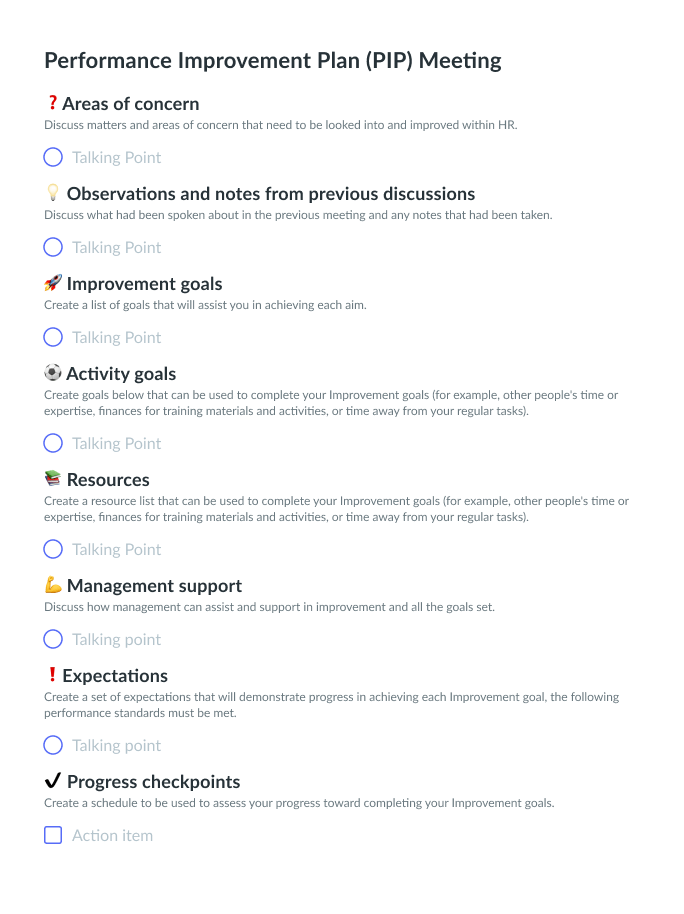
How to write a meeting objective
Here are the steps to take to start writing your own meeting objectives.
- Establish a clear meeting purpose
- Keep it clear, concise, and direct
- Ensure your goal can be measured
- Explain why the outcome matters
- Write the meeting objective in your agenda
- End your meeting by assessing whether the objective was met
1Establish a clear meeting purpose
Effective meeting objectives flow naturally from well-defined meeting purposes. That’s because the meeting purpose is the “why” of it all and the meeting objective is the “what.” When you know the broad reason you’re meeting, honing it down to a narrowly defined ideal outcome is easy. In fact, Fellow’s Meeting Guidelines prompt you to add a purpose to your meetings well ahead of time so everyone arrives energized and prepared.
2Keep it clear, concise, and direct
A one-sentence objective with simple, direct wording leaves little room for misunderstanding your goals. It also gives your team members much less to remember, making them more likely to know your objective well and in full. This, in turn, can hone their focus during your meeting.
3Ensure your goal can be measured
Success in meeting a goal isn’t abstract—it’s something you can quantify. Your meeting objective should reflect this with clear numerical targets. Examples could be: “identify three ways to cut $1,000 in monthly spending” or “decide on five employees to consider for a promotion.”
4Explain why the outcome matters
Getting your employees invested in a certain outcome starts with showing them how the result benefits them. For the “identify ways to cut $1,000 in monthly spending” objective, a benefit could be that this money can go toward higher-quality software. With this software, your team’s day-to-day gets much easier. Of course, since a meeting objective should be concise, you can’t add this explanation to it—create space in your meeting agenda for that. Speaking of which…
5Write the meeting objective in your agenda
A meeting objective isn’t set in stone until it’s in the meeting agenda that you’ve shared with your team. Not that a meeting objective is firmly committed once you write it—you can adjust it based on team feedback or new inspiration—but once it’s out there, it’s much closer to being final.
6End your meeting by assessing whether the objective was met
To truly be sure you’re successfully planning for and holding goal-oriented meetings, conclude with an analysis of whether you pulled off your objective. If so, great—you’re doing it right! If not, go over all these tips to see where you might be going wrong and figure out what to change. Powerful meeting objectives are right around the corner.
Parting advice
You’re much more likely to wrap up your meeting with confidence that you’ve achieved everything you hoped if you write strong meeting objectives. The old adage, “keep it simple, stupid” definitely applies here—the best objectives are compact and not complex, and they’re measurable too. Make sure to use Fellow to record clear meeting objectives in AI-assisted meeting agendas that drive productive conversations across your organization!
![How to Set Productivity Goals for 2024 [+ Examples]](https://fellow.app/wp-content/uploads/2023/12/productivity-goals-2.jpg)








